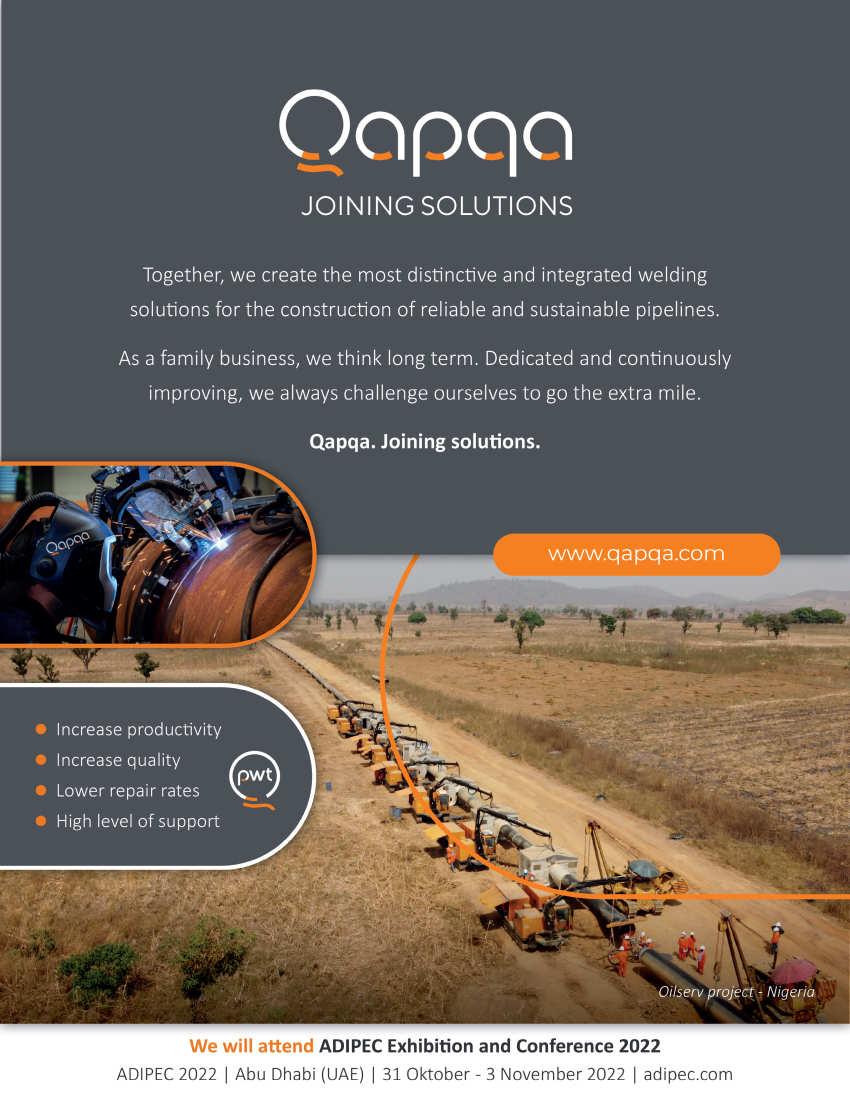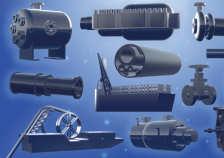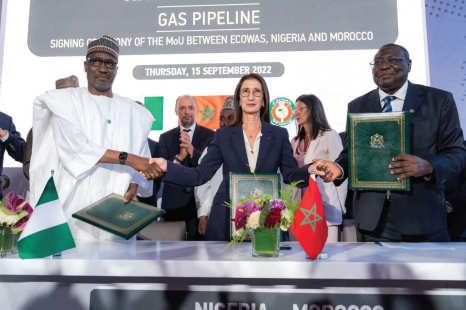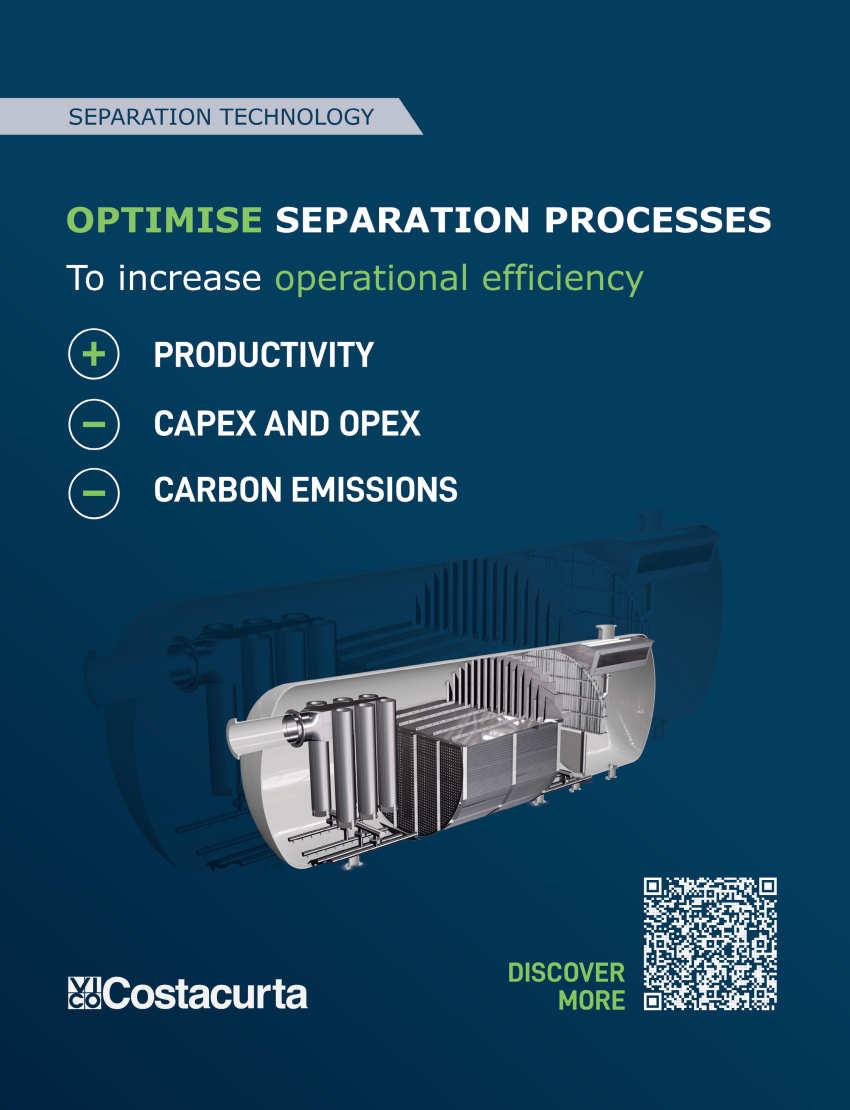
13 minute read
Reliable leak monitoring for pipelines
Reliable leak monitoring
for pipelines
Jay Gadhavi, KROHNE Middle East and Africa solutions director, discusses the benefits of Extended Real Time Transient Modelling (E-RTTM) leak detection systems as a central component of pipeline safety design.
Transportation of fluids in pipelines is increasing all over the world, and with good reason: pipelines are among the safest and most economical transportation systems over long routes. Special leak detection systems are often used to limit the risks. In general, leak detection in pipelines refers to the recognition and quick localisation of product leaks.
Reasons to employ leak detection include the following: • To minimise the effects of accidents • To minimise downtime • To minimise product loss • Regulatory compliance. Leak detection in pipelines can be performed in various ways, from simple visual controls during inspections, to computer-supported systems that monitor conditions, even for underground and undersea pipelines.
Getting started
Selecting a suitable leak detection system is not an easy task for pipeline operators. API RP (Recommended Practice) 1130 is even more specific with regard to leak detection systems. Among other items, it includes a collection of general recommendations for operating leak detection systems, such as clear presentation of the results for the operator and for maintenance. It also includes performance criteria for selecting a leak detection system: these criteria are very detailed and explain how leak detection systems work. The criteria are outlined below, and it is easy to see that they are linked and interdependent. • Sensitivity: the leak detection system should detect even small leaks within a short period. • Precision: the leak detection system should locate leaks precisely. The leakage rate, the quantity of escaped product (leakage
rate multiplied by time) and the product that is escaping should all be indicated. • Robustness: the leak detection system should continue active monitoring despite unsteady or non-ideal conditions. It also includes unsteady operating conditions, also known as transient operation, for example due to effects triggered by pumps or valves. • Reliability: the leak detection system should not generate false alarms, even though it is highly sensitive.
Canadian Standards Association CSA Z662 Annex E represents recommended practice for liquid hydrocarbon pipeline system leak detection in Canada. Hereby, the CSA Z662 Annex E is the only recommended practice to include precise uncertainties for leak detection systems.
When the operator has clarified relevant requirements of the appropriate regulatory for their application, other characteristics that affect the choice of leak detection system can be considered.
Combining principles has several advantages. In 2012, the U.S. Department of Transportation Pipelines and Hazardous Materials Safety Administration published a Leak Detection Study, DTPH56-11-D000001, which states: “The leak detection system itself should always be redundant, by using multiple techniques that differ from each other and therefore compensate for any inherent weaknesses they do not share.” It also describes the benefits of combined leak detection methods: “There is no reason why several different internal leak detection methods should not be implemented at the same time. As an example, the Extended-RTTM system trademarked by KROHNE uses an RTTM in conjunction with several other API 1130 techniques”. (E-RTTM stands for Extended RTTM, which combines the RTTM principle
Leak detection minimises the effects of accidents, reduces downtime and product loss and aids compliance.

with leak signature analysis using leak pattern detection).
Benefits of E-RTTM systems

An E-RTTM leak detection system creates a virtual image of a pipeline based on real measured data. If the model detects a flow discrepancy, the leak signature analysis module then determines whether it was caused by an instrument error, a gradual leak or a sudden leak.
The increased capacities of modern computers allow leak signature analysis to apply powerful statistical hypothesis testing. Based on modern statistical tests, the signature analysis decides whether the pipeline is affected by a leak or not. It provides a high degree of sensitivity and quick leak detection with real-time comparison of existing measuring results against leak signatures, which are stored in a database. ERTTM-based leak detection systems are able to handle changing or transient operating conditions that are not recognised by less sophisticated internal leak detection systems. An E-RTTM-based leak detection system works with dynamic values, which also affects robustness: the system can adapt automatically and very quickly to changes in the operating conditions such as sensor failure, communications failure, a valve closing or a product change in the pipeline.
The precision of the E-RTTM is based on three different methods of leak localisation: the gradient intersection method, the wave propagation method and the extended wave propagation method. The leak detection system calculates the most probable leak location(s) by comparing the results of these methods. The gradient intersection method is based on the pressure profile of a pipeline: the occurrence of a leak changes the pressure gradient along the pipeline in characteristic manner. Without a leak, the drop in pressure in a liquid pipeline is linear. The leak position can be determined by calculating the intersection point.
The second option for leak localisation is the wave propagation method, which analyes the pressure waves that result from a leak. If a sufficiently large enough leak occurs suddenly, for example if the pipeline is damaged by an excavator, a negative pressure wave spreads at the speed of sound in both directions along the pipeline. The leak position can be calculated by comparing the arrival time of the pressure wave at the pipeline inlet and outlet pressure sensors.
The extended wave propagation method is based on the same physical principle as the wave propagation method. This enables more precise localisation of the leak by reducing errors due to delayed sensor reaction or slow signal transfer.
The E-RTTM introduced here is the basis of the PipePatrol leak detection system by KROHNE. The user interface can run on a separate workstation, or be integrated into an existing control system. The user interface features intuitive operation: only the information that the current user needs for his scope of work is displayed.
In principle, PipePatrol can be integrated into any new or existing infrastructure. Operators can learn to use the system in just a few hours. In addition to the visualisation of the pipeline operating conditions, PipePatrol can indicate leak positions on a map, which simplifies and speeds up a service technician's work.
An E-RTTM leak detection system creates a virtual image of a pipeline based on real measured data.
Leak detection in practice
An example application in Canada demonstrates how quickly and precisely leak detection functions in practice. Following thorough consultation, the company opted for the PipePatrol leak detection system. PipePatrol used the measurement values provided by the process control system and was integrated into the pipeline monitoring system at the customer’s request. The leak tests performed for the site acceptance tests were conducted using valves in the pipeline to simulate leaks by real fluid withdrawal into a vacuum truck. The detection threshold for leaks is set to 1.1 m³/h / 4.84 gal (US)/min . After starting the leak test with a leak rate of 5 m³/h / 22.01 gal (US)/min, the system recognized the signature of the leak within 55 seconds and went to “Leak Signature Detected” state.
The gradient intersection method calculated a leak position of 24,689 m / 15.34 mi, while the wave propagation method calculated a leak position of 24,677 m / 15.33 mi, both less than 0.1% of pipeline length away from the real leak position.
The second pipeline is a sales oil pipeline with a length of 59,700 m / 37.1 mi. The detection threshold for leaks is set to 3 m³/h / 13.21 gal (US)/min. After starting the leak test with a leak rate of 3.5 m³/h / 15.41 gal (US)/min, the system recognised the signature of the leak within 50 seconds and went to “Leak Signature Detected” state. The gradient intersection method calculated a leak position of 0 m / 0 mi, less than 0.1% of pipeline length away from the actual leak position. The wave propagation method was disabled for this test because time stamping was temporarily not available for the measurements, but has been activated in the meantime.
Modern leak detection systems are based on various mathematical and physical models. E-RTTM-based leak detection systems guarantee reliable leak monitoring for various types and lengths of pipelines, even under transient operating conditions. KROHNE supplies the PipePatrol E-RTTM-based leak detection system either installed on separate hardware or for integration into an existing control system and measurement installation, always to international standards trusted by the industry.
N'GENIUS has launched a new series of highstrength, austenitic stainless steels, which can transform how materials are specified and utilised across the oil and gas sector. It is a reinvention of conventional austenitic stainless steels and has been specifically developed to out-perform, supersede and supplement the majority of existing grades.
CV Roscoe, inventor of the original 25Cr super-duplex stainless steel and CEO of N'GENIUS Materials Technology, explained, “The extensive range of alloy types, variants and grades in the N’GENIUS Series have strength properties equivalent to duplex and super-duplex stainless steels, ductility and toughness levels normally associated with conventional austenitic stainless steels but with far superior corrosion resistance to suit all major oil and gas projects.
“In terms of oil and gas production system design, the series has been developed to be the total system material solution. A vast array of wrought and cast products and equipment can be manufactured and supplied in the series for onshore and offshore oil and gas production systems.”
Subsea umbilicals, catenary risers and flowlines, manifolds, subsea bundles, well heads, fittings, flanges, compact flanges, hub connectors and engineered products such as pumps and valves are among these products and equipment. As are fabricated products such as offshore topside systems including spools, modules, static risers, process piping systems, seawater cooling systems, firewater systems, filtration systems, heat exchangers and various ancillary equipment including tanks, vessels and structures.
The N'GENIUS Series of CRA line pipe grades are available in both seamless and welded product forms. Specifically, they will address the need for a much wider selection of corrosion resistant alloy (CRA) line pipe materials that are suitable in a wide range of service conditions and process media environments for all types of onshore projects and offshore projects in shallow, deep and ultra-deep water that can be installed using the various installation methods including Slay, J-lay, Reel-lay and subsea Bundle installation techniques.
Perfectly suited for Oil Country Tubular Goods (OCTG) casing and tubing, the series helps overcome the dilemmas caused by elevated temperatures, high pressures and higher mechanical loads, while its improved corrosion resistance provides a robust defence even in harsh process media environments containing various levels of chlorides, CO2, H2S and other constituents. It also ensures the very best resistance to hydrogen embrittlement and, in particular, stress corrosion cracking (SCC) in aggressive media environments which can often be a major obstacle for OCTG.

Typical applications for the new austenitic stainless steels.
Image Credit: N’GENIUS
For details, visit: www.ngeniusmaterials.com.

The MoU attests to the commitment of ECOWAS and the concerned countries to the pipeline’s development.

Image credit: ECOWAS
A MEMORANDUM OF Understanding was signed on 15 September in Rabat, Morocco between the Economic Community of West African States (ECOWAS), the Federal Republic of Nigeria and the Kingdom of Morocco, for the Nigeria-Morocco gas pipeline project. The three sides were respectively represented by Sediko Douka, ECOWAS commissioner for Infrastructure, Energy and Digitalisation, Mallam Mele Kolo Kyari, group chief executive officer of Nigerian National Petroleum Company Limited (NNPC) and Amina Benkhadra, director general of Office National des Hydrocarbures et des Mines (ONHYM).
According to a published joint communiqué, the Memorandum of Understanding attests to the commitment of ECOWAS and all the countries crossed by the gas pipeline, to contribute to the feasibility and technical studies, the mobilisation of resources and execution of this strategic project. This project, once completed, will supply gas to all the countries of West Africa and will open a new channel of export to Europe. It will contribute towards improving the living standards of the population, integrating the economies in the region, decreasing the level of desertification thanks to a sustainable and reliable gas supply and a reduction in or outright end to gas flaring, among others, according to ECOWAS. 16 countries including 14 ECOWAS member states, are involved in this project. The project will also assist other countries such as Ghana, Côte d'Ivoire, Senegal and Mauritania to export their surplus natural gas.
The strategic Nigeria-Morocco gas pipeline project will traverse the West African coast from Nigeria to Morocco, through Benin, Togo, Ghana, Côte d'Ivoire, Liberia, Sierra Leone, Guinea, Guinea Bissau, The Gambia, Senegal and Mauritania. In the long term, it will be connected to the Maghreb-Europe gas pipeline and to the European gas network. It will also help cater to the land-locked countries of Burkina Faso, Mali and Niger.
Commissioner Sediko Douka, speaking on behalf of the ECOWAS Commission president, H.E Dr Omar Alieu Touray, said, “We, as a regional economic community, are convinced that it is indeed a viable project, one that holds great promise, and we will spare no effort for its success.”
The ECOWAS commissioner for Infrastructure, Energy and Digitalisation further reaffirmed, on behalf of the ECOWAS Commission president, total support for this regional project which would positively impact the lives of more than 400mn people.
“The project’s impact is far reaching because it would help ensure electricity supply in the West African region, and in the long term the export of natural gas as fuel in Europe. We have carefully monitored from beginning to end the feasibility studies at the various levels of validation,” he revealed, adding that the next phase would involve the detailed design of execution, resource mobilisation and the actual construction.
With the launch of the project, efforts will be made to attract public and private investors including multilateral or commercial banks, pension funds and insurance companies, among others. The project will span 6,000 km and cost US$25bn. The financing of the project is expected to involve several stakeholders.
Hiber debuts satellite-powered pipeline monitoring solution
HIBER, THE IOT as a service provider that serves the oil and gas sector, has expanded the capabilities of its HiberHilo solution to transform remote pipelines into continuous digital streams of operational data. HiberHilo pipeline monitoring makes it economically feasible to include constant monitoring of even the most remote pipelines to reduce risk, increase uptime and lower operational and maintenance costs.
“Our oil and gas customers have been extremely satisfied with the capabilities of HiberHilo on wellheads, and challenged us to deliver a more comprehensive network view of their extraction and distribution operations – especially those situated in remote areas where it’s economically unfeasible to implement an over-the-air digital connection,” said Hiber CEO Roel Jansen.
Image credit: Adobe Stock
Pipelines can present environmental and reputational risk to oil and gas operators.
Pipelines present potentially enormous environmental and reputational risk to oil and gas operators, but until now, monitoring them has been expensive. For example, the pigging of a pipeline is important for maintenance and to optimise flow, but it is costly. By monitoring the pressure, flow, or temperature of a pipeline and its contents at strategic points, HiberHilo helps optimise the operation of pipelines at a low price. This is especially valuable for pipelines in gathering networks or remote parts of transmission networks.
“With HiberHilo’s new, expanded capabilities, we can deliver reliable monitoring services to remote pipelines at a breakthrough price. This means operators gain access to efficient and economical operation of more of their pipelines, enabling higher throughput, improved pipeline integrity and safety across more of their pipeline networks, while meeting risk management and sustainability goals,” added Jansen.







